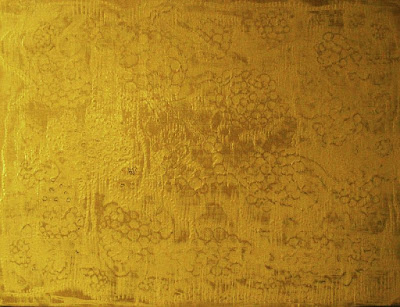I went back to some of the larger canvases on day 9 in the studio. With one of them I finally felt I'd come to the point where I could start drawing a shape against all the texture of the background:
I used the broken dot pattern to maintain balance with all the rest that's going on in the picture. I have a feeling that this one will be finished in a few days.
With the other one, I had a bit of a disaster when the bottle I was using to paint from broke and spilled all over the surface. So I just spread the paint out over the whole canvas and decided to use it as another layer:
All the dots and textures are so thick that they're still visible through the new wash of paint anyway. So not so much a disaster -- more of a happy accident.
I used my good camera today, but it's still difficult to take a set of photos of the same painting with a consistent tone. In other words, the colours in these photos are a good approximation, but I will need to take them outdoors to get a better representation of the actual colours. And currently it's in the low twenties Fahrenheit outside, so ...
 Subscribe to Praeterita in a reader
Subscribe to Praeterita in a reader
I used the broken dot pattern to maintain balance with all the rest that's going on in the picture. I have a feeling that this one will be finished in a few days.
With the other one, I had a bit of a disaster when the bottle I was using to paint from broke and spilled all over the surface. So I just spread the paint out over the whole canvas and decided to use it as another layer:
All the dots and textures are so thick that they're still visible through the new wash of paint anyway. So not so much a disaster -- more of a happy accident.
I used my good camera today, but it's still difficult to take a set of photos of the same painting with a consistent tone. In other words, the colours in these photos are a good approximation, but I will need to take them outdoors to get a better representation of the actual colours. And currently it's in the low twenties Fahrenheit outside, so ...

